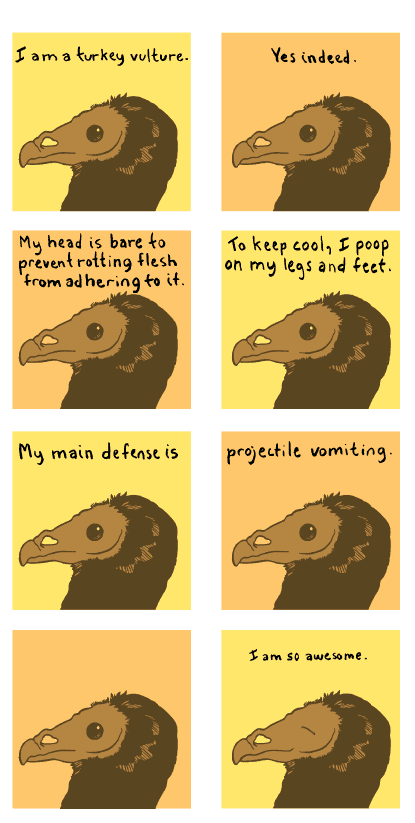
Some avian world surprises are more…appealing than others. Comic © bird and moon science and nature cartoons. More at http://www.birdandmoon.com/
A flash of brown in the undergrowth. There it goes, maybe flying into the branches of a tall Loblolly Pine? No, wait, it’s disappeared – I take my binoculars away from my eyes and scan the forest. Everyone is looking into the brush when a yell off to the right draws our attention; the thrush has been found, perched high on a branch overhanging the creek. “Who would’ve thought birds could be so exciting?” I think to myself.
I’ve always enjoyed watching birds flutter around my backyard, but for most of my life one bird seemed much like any other. These days, however, I’m identifying birds like it’s my job. The process of educating myself about the wonders of the avian world has been filled with surprises – for example, did you know that birds are directly descended from dinosaurs? That the Arctic Tern, with the longest migration of any bird, flies from the Arctic to the Antarctic and then back again? And don’t get me started on the winter seed-caching madness of chickadees!
Once you’re in the habit of noticing birds, I’ve found that a great tool to figure out what you’re looking at is the Merlin Bird Identification App. It’s completely free and completely easy to use – after downloading it onto your phone, it guides you through when and where you saw the bird, as well as its color and size. You can peruse the resulting list of “best matches,” reading about each species, looking at photos, and listening to bird calls. If you use it with kids, it’s a great way to get them thinking about why different kinds of birds prefer different habitats and seasons.
I was pleasantly surprised to learn how rewarding it can be to pay more attention to birds. Whether they are rare winter migrants or pigeons in the park, most of the fun comes from observing bird behavior. One of the books that I read to prepare for our Get Wild! program, called “What the Robin Knows” by Jon Young, makes the point that we can learn much more from birds than what a bird identification app will tell us. Young makes the case that when you hear a bird chirping or see it flying from ground to tree, these are meaningful actions – the bird is reacting to something in the environment that we might not even have noticed. This can be a predator, another bird, or even us!
The next time you’re on a walk in the woods, take a moment to sit, quietly, next to a creek or with a tree at your back. Observe the forest and its birds – what are they doing? Where are they going and how are they interacting with one another? Do they sound calm, or are they raising an alarm? In this way, birds can help us become more aware of the web of life that surrounds us whenever we venture outside.

